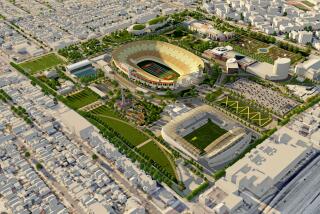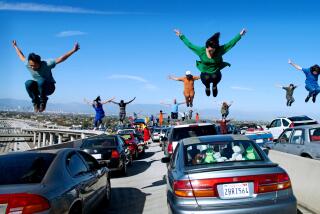Australia Plans World-Class Bash : Promoters of Expo ’88 Use L.A. Olympics as Model
- Share via
BRISBANE, Australia — Factories are churning out the last of the stuffed platypuses. The giant frilled-neck lizard is finished, as are the 1.5-mile, $12-million monorail and the solar-powered rain forest. And Swiss technicians are testing their indoor ski slope and gondola ride.
These are all signs that this “country town” of about 1 million on Australia’s remote northeast coast is on the verge of being discovered by the rest of the world.
Two months from now, 37 nations, six corporations and various local governments, including the state of California, will open their pavilion doors for the $600-million World Expo ‘88, which promises to rank as one of the most unusual and hedonistic affairs in exposition history.
And unlike the recent financial fiascoes in New Orleans, Knoxville and Vancouver, World Expo, billed appropriately for this laid-back nation as “Leisure in the Age of Technology,” most likely will be the first financially successful world’s fair in nearly two decades.
Through some creative financing, its organizers have artfully sidestepped some errors of past expos. Already they have received commitments from more than 8 million visitors and established an apparently iron-clad plan to recoup every cent spent on the fair.
For the U.S. government, which is spending more than $7 million on its Science in Sports pavilion, the fair has important political overtones, as well. The younger generation of Australians has turned against the presence of huge, top-secret U.S. military installations here, staging demonstrations in the streets of Sydney, Melbourne and other cities.
Bicentennial Party
At World Expo ‘88, they will see a different kind of U.S. presence--18 American gymnastic teams, 80 marching bands, a dozen leading sports scientists, a team of Ping-Pong playing robots and such top acts as the Mormon Tabernacle Choir. California plans to sponsor a daylong beach party, and Alaska will stage the “Eskimo Olympics”--all of it, as one American official here said, part of an effort at “keeping the Australian-American alliance healthy at a time when it is more vital than ever.”
But for Australia, the World Expo, scheduled to be open from April 30 to Oct. 30, is yet another important party in its bicentennial year campaign to be discovered by the outside world.
“This is the first world exposition in this century in the Southern Hemisphere,” said David Hennessy, the fair’s deputy director of international participation. “It has a very strong regional flavor, and we think it’s important for the world to discover that.”
Indeed, it has been a long time since a world’s fair sported pavilions from such little-known nations as Tonga, Brunei, Vanuatu, the Cook Islands, Western Samoa and Papua New Guinea.
Visitors will also be given a glimpse of the high-tech revolution here that has gone on largely unnoticed outside Australia, an island continent of 16 million people.
The snow on the Switzerland’s indoor pavilion slope, which will be manned by professional ski instructors, was developed by Australian scientists and is considered the most sophisticated artificial snow in the world.
Australia has also been the world’s leader in solar technology, and solar energy will power everything in the artificial rain forest at the fair site, including systems that provide lighting, mist and steam-vapor that simulate the environment of a real rain forest.
Human creation and development, from the embryo to old age, will be depicted through four miles of neon and three lasers in an Australian-built exhibit called Time Square.
And a sophisticated Australian software program called Lostots will use five consoles and 15 miles of underground data cables to permit parents to locate and then to see and talk with their lost children while they are being reunited on the fairgrounds.
Unlike most recent expos, though, nothing is for sale, everything for show.
“It’s important to stress that this is not a trade fair,” Hennessy said. “It’s an opportunity for countries to come along and let their imaginations go. And I think finally they’ve gotten the idea that they’re not down here to flog (sell) cans of mushrooms.”
While there will be daily laser shows and fiber-optics displays, all using Australian-made equipment, many exhibits will be cultural. The Vatican pavilion will display 300 treasures, centuries old, that have never been seen by the public, and Britain is bringing one of the four original copies of the Magna Carta.
For entertainment, there will be more than 25,000 performances during the expo’s six months of operation, ranging from opera to acid rock and including Johnny Cash, Air Supply, James Taylor and John Farnham. Daredevil divers will jump hundreds of feet into flaming pools at the Aquacade four times each day. Every day there will be two fantasy parades, led by giant mechanical creatures such as the native frill-necked lizard, that expo organizers promise “will rival Disneyland.”
Food will also be alluring. The French government has persuaded all the major Champagne houses of France to produce a special Expo Champagne. Two Australian chefs spent several months in the most remote provinces of the Soviet Union to prepare for the opening of the 250-seat Troika restaurant near the Soviet pavilion.
Site Key to Success
There will be a Munich beer hall and typical Brisbane-style Aussie pubs; these will be located in original, renovated riverfront buildings that expo organizers say were “once the scene of regular Saturday night blood baths in formerly notorious South Brisbane.”
The 99-acre expo site itself, which lies in what was once an iron-fisted longshoreman’s neighborhood along the Brisbane River, is the heart of what independent financial experts say will ensure the expo’s economic success.
To buy and clear the dilapidated site, the expo authority borrowed $200 million from the government. It promptly refinanced the loans through private banks, paid back the government and sought out private developers to repurchase the land when the expo ends. Already, there have been four solid bids, all of which, combined with expected ticket sales of about $40 million, would put the expo into the black.
Private corporations have contributed massively to the fair. Led by IBM Australia, which has spent $3.8 million on its own pavilion and contributed $2 million in computers to the expo authority, dozens of companies from Australia, the United States and Japan have committed $120 million to the expo, some of it in exchange for rights to manufacture official World Expo souvenirs--chief among them the expo mascot. This is a stuffed version of the platypus, the furry, duck-billed mammal native only to Australia.
Fuji is launching a new compact camera with the World Expo logo, and Seiko Time, producer of the Disneyland watches, is making a special Expo Oz watch as a souvenir.
“We’ve been accused at times of being too commercial,” expo general manager Bob Minnikin said, “but you can’t do it both ways.”
He cited the Los Angeles Olympics as the model of success emulated by the expo organizers of Brisbane.
“New Orleans gave expos a bad name in terms of funding, and we’re convinced we’ve found the way to change that around. And it’s been, in some ways, easier to just lay it on the line to people and say we’re not a government-run organization. We can’t lose money on this.”
The expo will bring about 14,000 new jobs to Brisbane and an economic stimulus of up to $1 billion, but the city will not be the only beneficiary.
The expo site is just one hour’s drive from some of the world’s most spectacular surfing beaches on Queensland’s Gold Coast and Sunshine Coast, and the fair is expected to boost tourism in general to the region, which has yet to be discovered by most Americans.
At least one Gold Coast luxury hotel has scheduled daily jet-foil rides between the beach and the riverside expo site, and organizers are even planning daily river ferries from the international airport, which also lies near the Brisbane River.
David Seal, the U.S. government’s deputy commissioner general in Brisbane who is overseeing the American participation in the fair, says the most important aspect of the World Expo ’88 is “that it will pay for itself.”
“You could have kissed world’s fairs goodby after Knoxville and New Orleans,” Seal said. “But here is going to be a world’s fair that works and shows that expos really are just a celebration of the culture of peaceful harmony.
“It’s not going to be a trade fair where everyone stands around with an order form in their hands. It’s going to be a good party in a country that loves a good party.”
Mark Fineman, chief of The Times’ Manila bureau, recently was on assignment in Australia.
More to Read
Sign up for Essential California
The most important California stories and recommendations in your inbox every morning.
You may occasionally receive promotional content from the Los Angeles Times.










